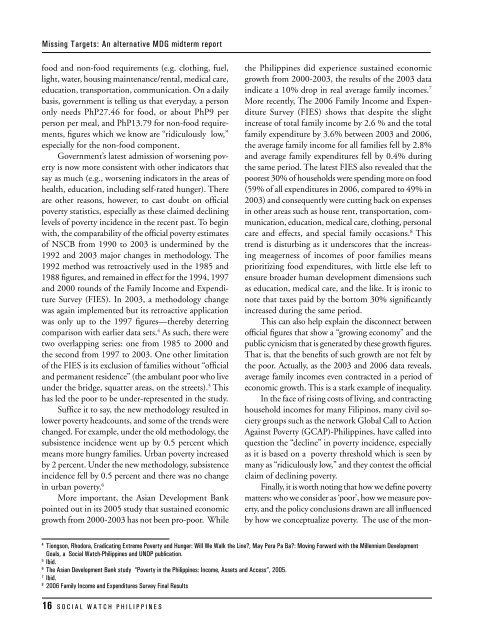one big file - Social Watch
one big file - Social Watch
one big file - Social Watch
You also want an ePaper? Increase the reach of your titles
YUMPU automatically turns print PDFs into web optimized ePapers that Google loves.
Missing Targets: An alternative MDG midterm report<br />
food and non-food requirements (e.g. clothing, fuel,<br />
light, water, housing maintenance/rental, medical care,<br />
education, transportation, communication. On a daily<br />
basis, government is telling us that everyday, a person<br />
only needs PhP27.46 for food, or about PhP9 per<br />
person per meal, and PhP13.79 for non-food requirements,<br />
figures which we know are “ridiculously low,”<br />
especially for the non-food comp<strong>one</strong>nt.<br />
Government’s latest admission of worsening poverty<br />
is now more consistent with other indicators that<br />
say as much (e.g., worsening indicators in the areas of<br />
health, education, including self-rated hunger). There<br />
are other reasons, however, to cast doubt on official<br />
poverty statistics, especially as these claimed declining<br />
levels of poverty incidence in the recent past. To begin<br />
with, the comparability of the official poverty estimates<br />
of NSCB from 1990 to 2003 is undermined by the<br />
1992 and 2003 major changes in methodology. The<br />
1992 method was retroactively used in the 1985 and<br />
1988 figures, and remained in effect for the 1994, 1997<br />
and 2000 rounds of the Family Income and Expenditure<br />
Survey (FIES). In 2003, a methodology change<br />
was again implemented but its retroactive application<br />
was only up to the 1997 figures—thereby deterring<br />
comparison with earlier data sets. 4 As such, there were<br />
two overlapping series: <strong>one</strong> from 1985 to 2000 and<br />
the second from 1997 to 2003. One other limitation<br />
of the FIES is its exclusion of families without “official<br />
and permanent residence” (the ambulant poor who live<br />
under the bridge, squatter areas, on the streets). 5 This<br />
has led the poor to be under-represented in the study.<br />
Suffice it to say, the new methodology resulted in<br />
lower poverty headcounts, and some of the trends were<br />
changed. For example, under the old methodology, the<br />
subsistence incidence went up by 0.5 percent which<br />
means more hungry families. Urban poverty increased<br />
by 2 percent. Under the new methodology, subsistence<br />
incidence fell by 0.5 percent and there was no change<br />
in urban poverty. 6<br />
More important, the Asian Development Bank<br />
pointed out in its 2005 study that sustained economic<br />
growth from 2000-2003 has not been pro-poor. While<br />
the Philippines did experience sustained economic<br />
growth from 2000-2003, the results of the 2003 data<br />
indicate a 10% drop in real average family incomes. 7<br />
More recently, The 2006 Family Income and Expenditure<br />
Survey (FIES) shows that despite the slight<br />
increase of total family income by 2.6 % and the total<br />
family expenditure by 3.6% between 2003 and 2006,<br />
the average family income for all families fell by 2.8%<br />
and average family expenditures fell by 0.4% during<br />
the same period. The latest FIES also revealed that the<br />
poorest 30% of households were spending more on food<br />
(59% of all expenditures in 2006, compared to 49% in<br />
2003) and consequently were cutting back on expenses<br />
in other areas such as house rent, transportation, communication,<br />
education, medical care, clothing, personal<br />
care and effects, and special family occasions. 8 This<br />
trend is disturbing as it underscores that the increasing<br />
meagerness of incomes of poor families means<br />
prioritizing food expenditures, with little else left to<br />
ensure broader human development dimensions such<br />
as education, medical care, and the like. It is ironic to<br />
note that taxes paid by the bottom 30% significantly<br />
increased during the same period.<br />
This can also help explain the disconnect between<br />
official figures that show a “growing economy” and the<br />
public cynicism that is generated by these growth figures.<br />
That is, that the benefits of such growth are not felt by<br />
the poor. Actually, as the 2003 and 2006 data reveals,<br />
average family incomes even contracted in a period of<br />
economic growth. This is a stark example of inequality.<br />
In the face of rising costs of living, and contracting<br />
household incomes for many Filipinos, many civil society<br />
groups such as the network Global Call to Action<br />
Against Poverty (GCAP)-Philippines, have called into<br />
question the “decline” in poverty incidence, especially<br />
as it is based on a poverty threshold which is seen by<br />
many as “ridiculously low,” and they contest the official<br />
claim of declining poverty.<br />
Finally, it is worth noting that how we define poverty<br />
matters: who we consider as ‘poor’, how we measure poverty,<br />
and the policy conclusions drawn are all influenced<br />
by how we conceptualize poverty. The use of the mon-<br />
4<br />
Tiongson, Rhodora, Eradicating Extreme Poverty and Hunger: Will We Walk the Line, May Pera Pa Ba: Moving Forward with the Millennium Development<br />
Goals, a <strong>Social</strong> <strong>Watch</strong>-Philippines and UNDP publication.<br />
5<br />
Ibid.<br />
6<br />
The Asian Development Bank study “Poverty in the Philippines: Income, Assets and Access”, 2005.<br />
7<br />
Ibid.<br />
8<br />
2006 Family Income and Expenditures Survey Final Results<br />
16 S O C I A L W A T C H P H I L I P P I N E S

















